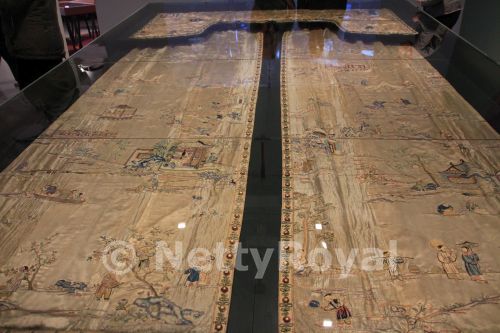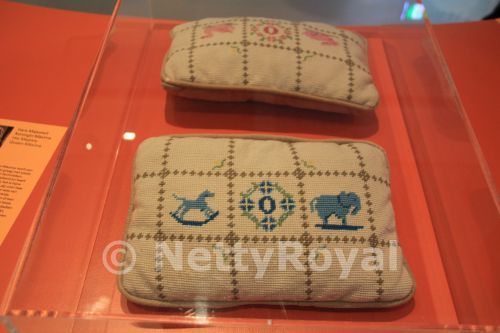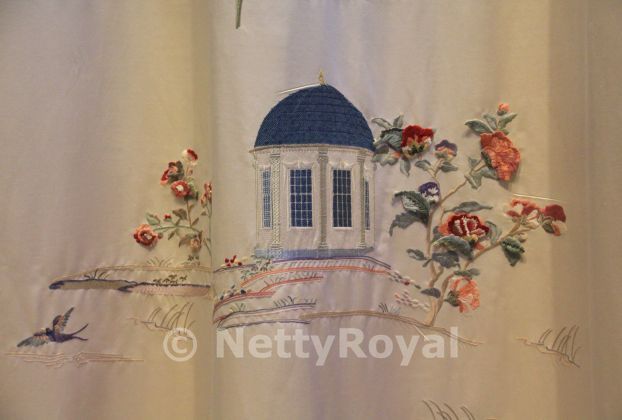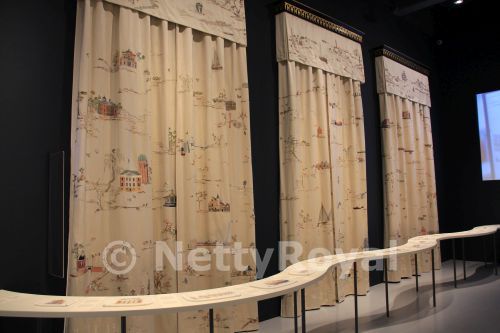On 30 November 2022 Queen Máxima of the Netherlands opened a rather special exhibition at the TextielMuseum in Tilburg, The Netherlands. Not only did she unveil the new curtains for the Chinese Room of her residence Palace Huis ten Bosch, she also participated in creating these curtains herself. After a three-year-renovation the Queen, her husband King Willem-Alexander and their three daughters the Princess of Orange (Amalia), Princess Alexia and Princess Ariane finally moved into the palace in January 2019. In 2017 the exhibition Koninklijk Paradijs – Aert Schouman en de verbeelding van de natuur (Royal Paradise – Aert Schouman and the imagination of nature) at the Dordrechts Museum already showed the restored wall-hanging ordered by Stadtholder Willem V in 1786, which shows his special animal collection. Now it was the turn of the new curtains to be shown to the people.


The exhibition
Koninklijk borduren – verhalen en vakmanschap (Royal embroidery – stitches and stories) opened its doors on 1 December 2022, and will be open until 29 May 2023. Whether you’re interested in embroidery or textiles, design or a royalty watcher, this exhibition ensures an interesting visit. A visit to the Palace is for most of us quite unlikely, but the exhibition offers a unique glimpse inside the building.
Upon entering the exhibition visitors first learn how the old curtains and for example embroidered fire screens – that are being exhibited too – found their way to the Netherlands in the year 1791 as part of a lavish present by the former Dutch East India Company director Ulrich Gualtherus Hemmingson. He presented the silk, hand embroidered fabric from Canton (Guangzhou), China, to Stadtholder Willem V and his wife Wilhelmina, who loved Chinese art. The material was used for curtains and to upholster the furniture in the apartment of the Stadtholder, in what is now the Chinese Room.
The curtains are nowadays too fragile, and a team of restorers and curators recently decided that they can’t be rehung in the palace. Before they are being conservated they are now shown at the exhibition, behind glass of course. They look surprisingly good and the colours are still wonderful. But if you look closely, you can see that the quality of the fabric is not as good anymore as it used to be. In another room you can see some embroidery by the groups that worked on the curtains, including two small pillows that Máxima herself embroidered when she was pregnant with her first child. A behind-the-scenes look at the creative process is given while highlighting the craftsmanship, passion and personal stories of the embroiderers involved. Another room shows the process of designing and creating the curtains.
The last room contains the new curtains including information about the objects embroidered on them. I found it fascinating. One can look for ages and see something new each time: flowers, people, boats, birds, animals, bridges, buildings. You will discovers the Mauritshuis, Palace Huis ten Bosch, the Royal Palace in Amsterdam, the Palace Council House in Tilburg, Palace Het Loo, the Prinsenhof in Delft, the royal yacht De Groene Draeck and a lot more. Not highlighted is what the Queen herself embroidered, but she worked on the flowers on the right of the tea house next to the pond of Het Oude Loo Castle in Apeldoorn.
The exhibition can only be visited in time slots and with a valid e-ticket. To be sure you can go in, you can book in advance via the ticket shop. For people interested an audio tour is available. After your visit I recommend to see the other parts of the museum and pay a visit to the café next to the entrance hall. The cake I had was absolutely delicious.



The curtains
To replace the old curtains designer Liesbeth Stinissen was asked to create a contemporary design based on the historical curtains. She found inspiration in the original embroidery, that showed scenes of Chinese architecture and daily life. She developed the machine and hand embroidery in collaboration with couture embroidery expert Anna Bolk, product developer Frank de Windt from the TextielLab and upholsterer Oostendorp.
For the machine embroidery, Liesbeth Stinissen selected silk yarns in 34 colours that closely resembled the palette of the original curtains. She also chose several stitches from the 177 available in the Stitch Library. Samples were made of the various motifs. After several tests the perfect combination of stitches, thread tension and other details was found. A mock-up was also produced using both machine and hand embroidery. After approval, product developer Frank de Wind converted each design into an embroidery file.
After the designs by Stinissen were delivered digitally they were converted for the embroidery software and the colour, stitch type, lenght, density and embroidery direction had to be programmed. More than 150 craft lovers of 16 craft groups from various backgrounds and walks of life, including Queen Máxima herself, helped to embroider the new curtains, overseen by Anna Bolk, who also gave them a masterclass. The Queen visited Tilburg several times during the whole process. The craft lovers embroidered flora and fauna motifs, that then at the Royal Palace in Amsterdam were appliquéd by hand onto the machine-embroidered curtains by Anna Bolk and her team, creating a three-dimensional layer.
The embroidered fabric is a silk and cotton blend. On the new curtains three thematic walks through the Netherlands in 60 embroidered scenes were developed on six curtains and three lambrequins (top panels). The blue walk symbolises the Dutch relationship with water, associated built structures and everyday scenes. The theme of the green walk is nature, art and science. The orange walk incorporates motifs that are connected to Dutch history and political, social or personal stories related to the House of Orange. The Wadden Islands are at the top of the design, Limburg on the bottom right. Also included are natural motifs from the historical curtains.
Do you want to try to embroider some of the flowers on the curtains yourself? An embroidery pattern of can be found on the royal website (in Dutch).

Fascinating exhibition. No catalogue, book, however. I contacted them.